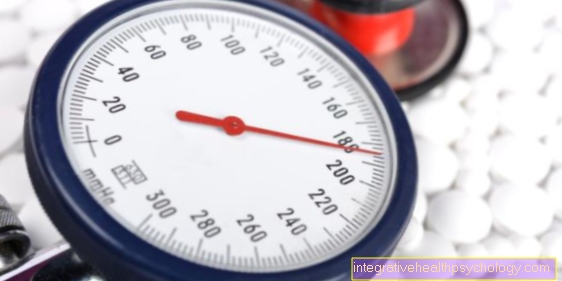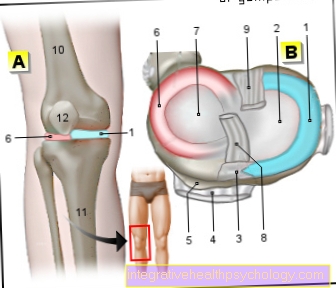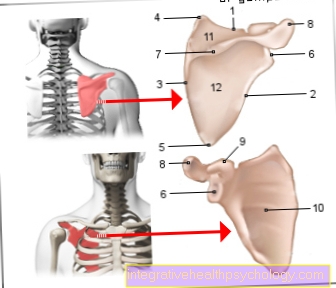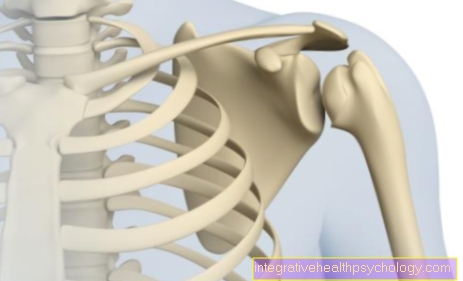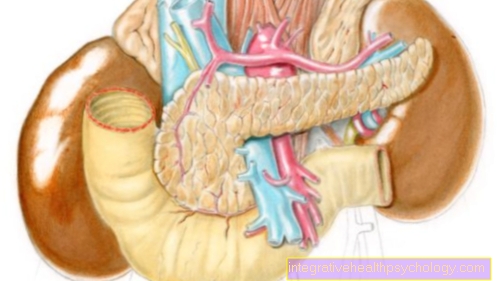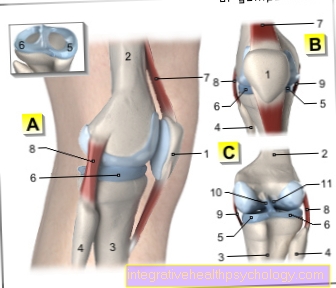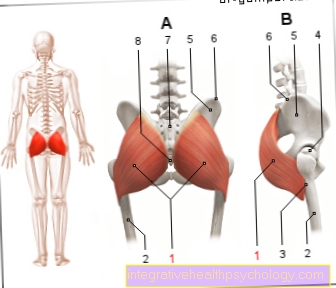CRP value
introduction
The CRP value is a parameter that is measured very often in everyday clinical practice. CRP, also called C-reactive protein, is one of the so-called pentraxins. These are mostly immune defense proteins. It belongs to the acute phase proteins, which are mainly increased in inflammatory reactions of various kinds.

What is the CRP value?
The CRP is made in the liver. A certain amount of CRP is naturally present in the blood of healthy people. The CRP is part of the immune system and performs an important role. It is able to bind to the cell membrane of pathogens (e.g. exogenous cells, germs). With the help of this bond, it marks the pathogens for other cells of the immune system, such as phagocytes (Macrophages). This allows phagocytes to recognize the cells and render them harmless.
Furthermore, the CRP can activate the complement system, which consists of many different proteins and also plays an important role in the immune system.
The CRP value is therefore higher especially when the immune system is working and activated to a particularly high degree. This is especially the case with inflammation. The inflammation can be of an infectious nature, but it can also have a non-infectious cause such as an autoimmune disease.
The CRP value shows us that inflammatory processes are taking place in the body. It can be used as an early marker for inflammatory diseases such as appendicitis, diverticulitis or urinary tract infections, as it increases earlier than other laboratory parameters.
In addition, the CRP value can be used to monitor the progress of various diseases. A decrease in the value indicates an improvement in the inflammation, an increase rather an increase.
However, the CRP value is a non-specific marker that cannot provide any information about where the inflammation is. In the case of acute inflammation, it can increase to 10 to 1000 times its initial value within a few hours. It is determined from the blood serum. A blood sample is required for this.
Progress values that can be compared with each other are particularly meaningful. They say more than a single absolute value.
Normal values of the CRP
The CRP is also found in the blood of healthy people. The reference values vary from person to person. The value also depends on the measurement method and the laboratory that determined the value.
For adults values up to approx. 10 mg / l apply (Milligrams per liter) or 1 mg / dl (Milligrams per deciliter) as normal.This is different with newborns. Values <0.5 mg / dl or <5 mg / l are to be regarded as normal here. At a value of 10-40 mg / l one speaks of a slight increase. Values between 40-200mg / l are to be assessed as a moderate increase. From 200 mg / l one speaks of a strong increase in CRP.
To assess the CRP value, it is always important to compare the measured value with the reference value of the respective laboratory that recorded the measurement. Depending on the measurement method, the reference values can vary from laboratory to laboratory. So there are sometimes slight fluctuations in the standard values. If your value is therefore slightly higher and yet, according to the laboratory, corresponds to the standard, this can be easily explained by this fact.
Causes of an increase in CRP
There are many different causes that can lead to an increase in the CRP value. A distinction is made between a slight, moderate and strong increase in the CRP value.
Here is the main article Causes of increased CRP values
Slight CRP increase
Viral infections often only lead to a slight increase in the CRP value. Slight urinary tract infections or gastrointestinal inflammation can also cause a slight increase.
The CRP value then fluctuates between 10 and 50 mg / l.
The CRP level can also be slightly increased during pregnancy.
Causes of permanently slightly elevated CRP values
A moderately increased CRP value of 10-40 mg / l over a long period of time can be an indication of a viral infection or a parasite infestation.
The CRP also increases steadily during pregnancy.
In addition, smokers have permanent increases in CRP values.
Since the CRP value increases with the intensity of the inflammation, it also serves as a marker for chronic inflammatory processes. This includes the
- Rheumatoid arthritis,
- Crohn's disease
- Sprue or
- Ulcerative collitis.
The CRP value in pregnancy
There are usually moderate increases in CRP levels in pregnant women. However, there are no precise guidelines.
If the CRP value is very high during pregnancy, inflammation such as Cystitis or pneumonia should be excluded. Unspecific antibiotics that are only given because of the increase in CRP are strongly advised against. On the one hand, the indication for taking medication should be set very strictly during pregnancy and on the other hand, unnecessary antibiotic intake leads to the development of resistance.
also read: Medication during pregnancy - what you should be aware of
Strong increase in CRP value
There are many diseases in which CRP skyrockets. All these diseases have a pronounced inflammatory response in common. From values of about 200 mg / l one speaks of a strong increase in CRP. These mainly occur in the acute phase of inflammation. For example, in the case of infections such as urinary tract infections, it is possible for the CRP to reach 1000 times the reference value within a few hours. Most of the time, however, the value also drops again quickly.
Bacterial infections and inflammation, in particular, cause high CRP levels. Also with appendicitis, diverticulitis, gallbladder inflammation and with respiratory infections, the CRP can initially be greatly increased. Typically, however, the value drops again quickly here too.
Maximum values are achieved in the case of blood poisoning (sepsis) with the pathogen Staphylococcus aureus. Bacteria in the blood generally lead to a much greater increase in CRP than viruses.
Other reasons for a sharp increase in CRP are bacterial meningitis or pneumonia, major surgery, severe inflammation of the pancreas, or acute osteomyelitis.
In addition to this inflammation, tumor diseases or autoimmune phenomena can also lead to a sharp increase in CRP. Among other things, rheumatic diseases and chronic inflammatory bowel diseases (especially Crohn's disease in acute flare-ups) lead to a pronounced increase in CRP.
Another reason for a large increase in CRP is severe burns.
How does the CRP value change with different diseases?
CRP in rheumatism
Rheumatic diseases are characterized by autoimmune phenomena. In addition to rheumatoid arthritis (rheumatic joint problems), which most people are familiar with, other diseases such as collagenosis or vasculitides also belong to the rheumatic group.
In rheumatic diseases, many unspecific inflammatory parameters, including the CRP value, are increased, especially in the acute episode of the disease. With rheumatism, depending on the severity and severity of the disease, there can be very strong increases in CRP. The CRP value correlates with the inflammatory activity. So the stronger the inflammation, the higher the CRP value.
The ultimate cause for the development of many rheumatic diseases has not been established. In the case of rheumatic joint complaints (rheumatoid arthritis), an infectious cause is also being discussed, which in turn provokes a strong immune response and, as a result, a pronounced inflammatory reaction.
Read more about this at:
- Rheumatoid Arthritis and
- Causes Rheumatoid Arthritis
Typically, the CRP value in the acute episode of rheumatoid arthritis is increased to values above 100 mg / dl. It is important to note that the course of the CRP is particularly meaningful here. As already mentioned, the CRP value correlates with the inflammatory activity, but it is also important to look at the clinical picture.
For example, high CRP values, which decrease well under therapy, often show a much milder clinical picture than CRP values of the same level, which are permanently elevated. For patients with rheumatoid arthritis it can therefore be useful to note the course of the CRP values. Apart from that, it must also be noted that the values also fluctuate individually. For example, CRP values are permanently slightly higher in smokers than in non-smokers.
CRP in cancer
Cancer diseases often lead to a marked increase in the CRP value. However, it must be emphasized that the CRP is an inflammation parameter and not a tumor marker! An increase in CRP is therefore not a criterion and not a meaningful value for a tumor disease. So one should not falsely conclude that cancer is present because of an increase in the CRP value.
Furthermore, the CRP value is not a parameter for the course of a tumorous disease. An increase can only occur in the context of a tumor disease, also as an expression of an inflammatory reaction that is triggered by the cancer.
When a cancer is in remission, the CRP value also falls.
In the course of the disease, the CRP can rise to values of over 200 mg / dl.
You can also find more information at: CRP value in cancer
What is the significance of the CRP value in the case of pneumonia?
It is difficult to distinguish between acute bronchitis and pneumonia without an X-ray of the chest.
Besides the clinical signs like
- reduced rattling breathing noise,
- Fever,
- increased heart rate (tachycardia) and
- the lack of runny nose,
indicates an increased CRP value of over 30 mg / l on pneumonia. The detection of an elevated CRP value significantly improves the accuracy of the diagnosis of respiratory diseases.
Find out more at: Blood tests for pneumonia
CRP and blood poisoning
Sepsis is also known colloquially as blood poisoning and can still be fatal today, even if countermeasures are taken. In Germany up to 25% of sepsis patients die despite therapy.
The highest CRP values are measured in sepsis. The CRP value is used both for diagnosis and for monitoring the course of sepsis. When antibiotics are used, the CRP level drops continuously.
However, a more precise parameter is the lactate value in sepsis. It refers to the organ failure caused by sepsis. If the lactate value is above 4 mmol / l, one speaks of septic shock.
Is the CRP value increased in back pain?
Back pain as a symptom can be caused by various medical conditions. The classic back pain caused by muscular tension does not lead to an increase in the CRP value.
However, symptoms such as meningitis or spondylodiscitis can lead to a strong increase in the CRP value, as these diseases are characterized by inflammation.
Meningitis is the inflammation of the meninges that leads to headaches and fever, among other things. The pain can also spread to the spinal cord.
Spondylodiscitis is an inflammation of the intervertebral discs and vertebral bodies, which is also expressed as back pain.
How does the CRP value change after an operation?
After an operation, the CRP value can increase. This can, but does not have to, indicate an infection of the wound. It is more likely that the CRP value will rise moderately through the phases of wound healing, which are similar to inflammation.
During regular check-ups and blood tests, the CRP value and other inflammation markers, such as blood depletion (ESR), white blood cell count and other laboratory values should be recorded.
Find out more at: Wound healing disorder
How should the CRP value change when antibiotics are given?
Classically, the regular recording of the CRP value while taking antibiotics is used to monitor the course of the inflammation. If the antibiotic is working properly, a drop in the CRP value can be expected.
If the CRP does not decrease or even continues to increase, this can be an indication that the spectrum of activity of the selected antibiotic does not include the pathogen causing the inflammation. Then, if possible, a bacterial smear should be taken in order to precisely determine the spectrum of pathogens and to adjust the antibiotic therapy.
Can CRP levels be normal despite inflammation?
Because the C-reactive protein is formed in the liver, it can lead to a deficient production of the protein if the liver is severely damaged (e.g. liver failure, liver cirrhosis or a tumor of the liver). This means that the expected increase in CRP does not occur even if there is severe inflammation.
You might also be interested in: Diseases of the liver
Is there a CRP rapid test?
In order to be able to differentiate between bacterial and viral infections, there is a rapid test that determines the CRP value.
With a prick in the fingertip (similar to the blood sugar test that the diabetic regularly takes), the CRP in the drop of blood is approximately determined. It takes about 2 minutes to get the result.
For those with statutory health insurance at the AOK or IKK Gesund Plus in Saxony-Anhalt, the CRP rapid test is adopted (as of May 2018).
What is the meaning of CRP values in children?
Shortly after birth, the CRP value is actually of no informative value because it increases too slowly in newborns. The inflammation or infection is much more advanced than the CRP value indicates. The same applies to premature babies.
In older babies, a CRP of up to 15 mg / L is considered normal. In children, the CRP value reacts as in adults and is within the normal range up to 10 mg / l.
You might also be interested in: The most common children's diseases
How can I lower my CRP?
The CRP level decreases as the inflammatory response decreases. In the case of bacterial infections, antibiotics effectively help to stop the infection and the associated inflammation. This can cause the CRP value to drop very quickly.
There is not very much that can be actively done to lower CRP levels. It is advisable to stop smoking, as a higher CRP value can be expected in smokers compared to the non-smoking population. In addition, elevated CRP is also likely to be associated with what is known as metabolic syndrome. A normalization of body weight and a normalization of the fat levels in the blood, which is achieved through a healthy diet and moderate physical activity, can most likely also contribute to a normalization of the CRP level.
High levels of physical activity can temporarily increase CRP levels. But that's not unhealthy per se. However, if you are going through an infection and are being treated, we recommend some bed rest and rest for recovery.
Immunosuppressive drugs such as glucocorticoids (e.g. cortisone) also lower the CRP value. For example, they are administered in the acute phase of rheumatic inflammation.
On the same topic, read our main article on the topic as well How can I lower my CRP value?
Editor's recommendations
You might also be interested in these topics:
- CRP value in cancer
- Laboratory values
- Blood test
- Blood count






